The Contribution of GPR to the Historical Research of Urban and Rural Landscapes of Antiquity
Abstract
1. Introduction
2. Bibliographic Analysis
2.1. Methodology
2.2. Results
3. GPR Survey and Its Potential for Historical Studies
3.1. The Radargram as a Historical/Archaeological Source
3.2. The Study of the City and Ancient Urban Layout
3.3. The Study of Rural Settlements and Agricultural Organisation
4. Conclusions
Supplementary Materials
Author Contributions
Funding
Data Availability Statement
Conflicts of Interest
References
- Harzing, A.W. Publish or Perish, 2007. Available online: https://harzing.com/resources/publish-or-perish (accessed on 3 May 2022).
- Bi, H.H. Four problems of the h-index for assessing the research productivity and impact of individual authors. Scientometrics 2023, 128, 2677–2691. [Google Scholar] [CrossRef]
- Barone, P.M. Understanding Buried Anomalies: A Practical Guide to GPR; LAP Lambert Academic Publishing: Saarbrücken, Germany, 2016. [Google Scholar]
- Berard, B.A.; Maillol, J.-M. Multi-offset ground penetrating radar data for improved imaging in areas of lateral complexity—Application at a Native American site. J. Appl. Geophys. 2007, 62, 167–177. [Google Scholar] [CrossRef]
- Böniger, U.; Tronicke, J. Improving the interpretability of 3D GPR data using target–specific attributes: Application to tomb detection. J. Archaeol. Sci. 2010, 37, 672–679. [Google Scholar] [CrossRef]
- Conyers, L.B. Interpreting Ground-Penetrating Radar for Archaeology; Left Coast Press: Walnut Creek, CA, USA, 2012. [Google Scholar]
- Ernenwein, E.G.; Kvamme, K.L. Data processing issues in large-area GPR surveys: Correcting trace misalignments, edge discontinuities and striping. Archaeol. Prospect. 2008, 15, 133–149. [Google Scholar] [CrossRef]
- Ewen, C.R. The role of GPR in archaeology: A beginning not an End. North Carol. Archaeol. 2016, 65, 92–99. [Google Scholar]
- Goodman, D.; Piro, S. GPR Remote Sensing in Archaeology; Springer: New York, NY, USA, 2013. [Google Scholar]
- Leckebusch, J. Ground-penetrating radar: A modern three-dimensional prospection method, Archaeol. Prospect 2003, 10, 213–240. [Google Scholar] [CrossRef]
- Hicks, D. Limitations of Co-Citation Analysis as a Tool for Science Policy. Soc. Stud. Sci. 1987, 17, 295–316. [Google Scholar] [CrossRef]
- Glänzel, W.; Czerwon, H.J. A new methodological approach to bibliographic coupling and its application to the national, regional and institutional level. Scientometrics 1996, 37, 195–221. [Google Scholar] [CrossRef]
- Lerici, C.M. Prospezioni geofisiche nella zona archeologica di Vulci. In Alla Scoperta delle Civiltà Sepolte. I Nuovi Metodi di Prospezione Archeologica; Lerici Publishers: Milano, Italy, 1960. [Google Scholar]
- Fisher, E.; McMechan, G.A.; Annan, A.P. Acquisition and processing of wide-aperture ground-penetrating radar data. Geophysics 1992, 57, 495–504. [Google Scholar] [CrossRef]
- Nawawi, M.N.M.; Abdullah, M.Z. Application of geophysical methods for quantitative archaeological investigations. In SEG Technical Program Expanded Abstracts 1996; Society of Exploration Geophysicists: Houston, TX, USA, 1996; pp. 770–773. [Google Scholar]
- Seren, S.S. Ground penetrating radar (GPR) as a powerful tool in archaeological prospection. In Proceedings of the 4th EEGS Meeting, Barcelona, Spain, 14–17 September 1998; European Association of Geoscientists & Engineers: Utrecht, The Netherlands, 1998; p. cp-43. [Google Scholar]
- Neubauer, W.; Eder-Hinterleitner, S.A.; Seren, P.M. Georadar in the Roman civil town Carnuntum, Austria: An approach for archaeological interpretation of GPR data. Archaeol. Prospect. 2002, 9, 135–156. [Google Scholar] [CrossRef]
- Piro, S.; Goodman, D.Y.; Nishimura, Y. The study and characterisation of Emperor Traiano’s villa using high-resolution integrated geophysical surveys. Archaeol. Prospect. 2003, 10, 1–25. [Google Scholar] [CrossRef]
- Campana, S.; Piro, S. Seeing the Unseen: Geophysics and Landscape Archaeology; CRC Press: Delft, The Netherlands, 2009. [Google Scholar]
- Okamura, K. Interdisciplinarity revisited: Evidence for research impact and dynamism. Palgrave Commun. 2019, 5, 1–9. [Google Scholar] [CrossRef]
- Blondel, V.; Guillaume, J.; Lambiotte, R.; Lefebvre, E. Fast unfolding of communities in large networks. J. Stat. Mech. Theory Exp. 2008, 10, P10008. [Google Scholar] [CrossRef]
- Collar, A.; Coward, F.; Brughmans, T.; Mills, B.J. Networks in Archaeology: Phenomena, Abstraction, Representation. J. Archaeol. Method Theory 2015, 22, 1–32. [Google Scholar] [CrossRef]
- Lagóstena, L.; Ruiz Gil, J.A.; Martín Mochales, D.; Pérez Marrero, J.; Rondán-Sevilla, I.; Trapero Fernández, P.; Catalán González, F.J.; Ruiz Barroso, M. El establecimiento rústico alto-imperial de Miramundo (Puerto Real, Cádiz). Un caso de estudio mediante combinación de técnicas de investigación no invasivas. In Estudos Arqueológicos de Oeiras 29; Câmara Municipal: Oeiras, Portugal, 2021; pp. 57–64. [Google Scholar]
- Lagóstena, L.; Molina, J. La “figlina” como ámbito de investigación cuantitativa de la economía romana: Aportación y potencial de la exploración georradar. In Ex Baetica Romam. Homenaje a José Remesal Rodríguez; Universidad de Alicante: San Vicente del Raspeig, Portugal, 2020; pp. 923–946. [Google Scholar]
- Brito, P.; Carreras, C. Aplicación de métodos geofísicos en arqueología: Una recopilación sobre el actual estado de la cuestión en España. Sci. Herit. 2005, 1, 1–20. [Google Scholar]
- De Coulanges, F. La Cité Antique; Barnes & Noble: París, France, 1864. [Google Scholar]
- Platner, S.B.; Ashby, T. (Eds.) A Topographical Dictionary of Ancient Rome; Oxford University Press: Oxford, UK, 1929. [Google Scholar]
- Steinby, E.M. (Ed.) Lexicon Topographicum Urbis Romae; AbeBooks: Roma, Italy, 2000. [Google Scholar]
- Quilici Gigli, S.; Quilici, L. (Eds.) Atlante Tematico Di Topografia Antica; L’Erma di Bretschneider: Roma, Italy, 1990. [Google Scholar]
- Dirix, K.; Muchez, P.; Degryse, P.; Kaptijn, E.; Music, B.; Vassilieva, E.; Poblome, J. Multi-element soil prospection aiding geophysical and archaeological survey on an archaeological site in suburban Sagalassos (SW-Turkey). J. Archaeol. Sci. 2013, 40, 2961–2970. [Google Scholar] [CrossRef]
- Gaffney, V.; Patterson, H.; Piro, S.; Goodman, D.; Nishimura, D. Multimethodological approach to study and characterise Forum Novum (Vescovio, Central Italy). Archaeol. Prospect. 2004, 11, 201–212. [Google Scholar] [CrossRef]
- Keay, S.; Earl, G.; Hay, S.; Kay, S.; Ogden, J.; Strutt, K.D. The role of integrated geophysical survey methods in the assessment of archaeological landscapes: The case of Portus. Archaeol. Prospect. 2009, 16, 154–166. [Google Scholar] [CrossRef]
- Verdonck, L.; Launaro, A.; Vermeulen, F.; Millett, M. Ground-penetrating radar survey at Falerii Novi: A new approach to the study of Roman cities. Antiquity 2020, 94, 705–723. [Google Scholar] [CrossRef]
- Goodman, D.; Piro, S.; Nishimura, Y.; Patterson, H.; Gaffney, V. Discovery of a 1st century AD Roman amphitheater and other structures at the Forum Novum by GPR. J. Environ. Eng. Geophys. 2004, 9, 35–41. [Google Scholar] [CrossRef]
- Vermeulen, F.; Corsi, C. Ammaia I: The Survey. A Romano-Lusitanian Townscape Revealed; ARGU: Ghent, Belgium, 2012; Volume 8. [Google Scholar]
- Corsi, C.; Vermeulen, F. Ammaia and the making of a roman town: A contribution to urbanism studies in Lusitania. In Proceedings of the XVIII CIAC: Centro y Periferia en el Mundo Clásico/Centre and Periphery in the Ancient World, S. 14. Iberia y Las Hispaniae Iberia and the Hispaniae, Mérida, Spain, 13–17 March 2013; pp. 1741–1746. [Google Scholar]
- Verdonck, L.; Taelman, D.; Corsi, C.; Vermeulen, F. Ground Penetrating Radar at Ammaia. In AMMAIA I: The Survey. A Roman Lusitanian Townscape Revealed; Academia Press: Ghent, Belgium, 2012; pp. 69–81. [Google Scholar]
- Bernardes, J.P.; Rondán-Sevilla, I.; Candeias, C.; Ruiz, M. Non-Invasive Prospection Methods in the Roman City of Balsa (Luz de Tavira-Portugal): Revealing the Real Townscape. Land 2022, 11, 1785. [Google Scholar] [CrossRef]
- Lagóstena, L.; Ruiz Gil, J.A.; Pérez-Marrero, J.; Trapero, P.; Catalán, J.; Rondán, I.; Ruiz-Barroso, M. Three coloniae and three municipia: Non-invasive exploration of urban contexts in Roman Hispania. In Proceedings of the Non-Intrusive Methodologies for Large Area Urban Research. Roman Transformed Conference, Almeria, Spain, 1–2 July 2021. In Press. [Google Scholar]
- Novo, A.; Sala, R.; Morelli, G.; Leckebusch, J.; Tremoleda, J. Full wave-field recording: STREAM X at Empuries (Girona, Spain). In Proceedings of the Archaeological Prospection—9th International Conference, Izmir, Turkey, 19–24 September 2011; pp. 213–217. [Google Scholar]
- García Sánchez, J.; Costa-García, J.M. Teledetección y prospección geofísica en Veladiez. Un sector inédito de la ciudad romana de Segisamo (Sasamón, Burgos). Cuad. Lab. Xeológico Laxe 2021, 43, 41–60. [Google Scholar] [CrossRef]
- Fuertes Santos, M.C. Lo que la tierra esconde. La ciudad romana de Ategua, Córdoba. In Small Towns, Una Realidad Urbana En La Hispania Romana; Mateos, P., Olcina, M., Pizzo, A., Schattner, T.G., Eds.; Instituto de Arqueología de Mérida: Mérida, Spain, 2022; Volume 2, pp. 445–458. [Google Scholar]
- Mateos Cruz, P.; Pizzo, A.; Mayoral Herrera, V. El paisaje urbano de Contributa Iulia Ugultunia (Medina de la Torres, Badajoz). Ciudad. Romanas Extremad. Stud. Lusit. 2014, 8, 113–133. [Google Scholar]
- Álvarez Martínez, J.M.; Iglesias Gil, J.M.; Jiménez Chaparro, J.I.; Teichner, F. Prospecciones geofísicas en Regina Turdulorum (Casas de Reina, Badajoz). Aplicación al conocimiento de su territorio urbano. In Proceedings of the La Revalorización de Zonas Arqueológicas Mediante el Empleo de Técnicas no Destructivas: Reunión Científica, Mérida, Badajoz, Spain, 12–13 June 2014; coord. por Victorino Mayoral Herrera. 2016; pp. 161–171. [Google Scholar]
- Ruiz-Barroso, M.; Rondán-Sevilla, I.; Catalán González, J.; Lagóstena, L.; Rodríguez, J.R. Lectura de Arva Desde la Investigación no Invasiva de la Urbs y el Suburbium, Small Towns. Una Realidad Urbana en la Hispania Romana; MYTRA 10; Instituto de Arqueología de Mérida: Mérida, Spain, 2022; pp. 459–467. [Google Scholar]
- Lagóstena, L. Estructura de la ocupación rural romana en las campiñas hastenses: Problemática y aportación de la exploración GPR a su conocimiento. In Arqueología y Sociedad de los Espacios Agrarios: En Busca de la Gente Invisible a Través de la Materialidad del Paisaje; Anejos de AEsPA XCI: Rome, Italy, 2021; pp. 109–117. [Google Scholar]
- Teichner, F.; Illaregui, E.; Moreno Escobar, M.D.C.; Hermann, F.; Arribas Lobo, P. Ver lo invisible. Prospecciones geofísicas en el yacimiento arqueológico de Tiermes (Montejo de Tiermes, Soria). Anejos Oppidum 2021, 7, 105–123. [Google Scholar]
- Peña, J.A.; Teixidó, T.; Carmona, E.; Orfila, M. Prospecciones geofísicas en los hornos romanos de La Cartuja (Granada). Un ejemplo para obtener información a priori. Aqueología Territ. 2007, 4, 217–232. [Google Scholar]
- Van Limbergen, D. Amore per l’antico. Dal Tirreno all’Adriatico, dalla preistoria al medioevo e oltre. Studi di antichità in ricordo di Giuliano de Marinis. In Archaeologia Degli Impianti Vinari e Oleari Nelle Marche Romane: Stato Dell’arte, Aggiornamenti e Riflessioni; Baldelli, G., Lo Schiavo, F., Eds.; Department of Archaeology: Rome, Italy, 2014; pp. 365–572. [Google Scholar]
- Trapero, P.; Rondán-Sevilla, I.; Lagóstena, L. Innovative techniques to study Roman viticulture in Baetica. In Proceedings of the International Conference Vine-Growing and winemaking in the Roman World, Rome, Italy, 27–29 October 2021. [Google Scholar]
- Carneiro, A.; García Sánchez, J.; Stek, T.; Kalkers, R. Primeiros Resultados do Fronteira Landscape Project: A. Arqueologia da paisagem romana no Alto Alentejo. Al-Madan Online 2019, 22, 46–54. [Google Scholar]
- García Sánchez, J.; Sanchez-Simón, M. Estudio del edificio romano junto al lavajo El Monduengo. Nuevos datos del complejo de la villa romana de Almenara de Adaja-Puras, Valladolid. Munibe 2021, 72, 171–184. [Google Scholar] [CrossRef]
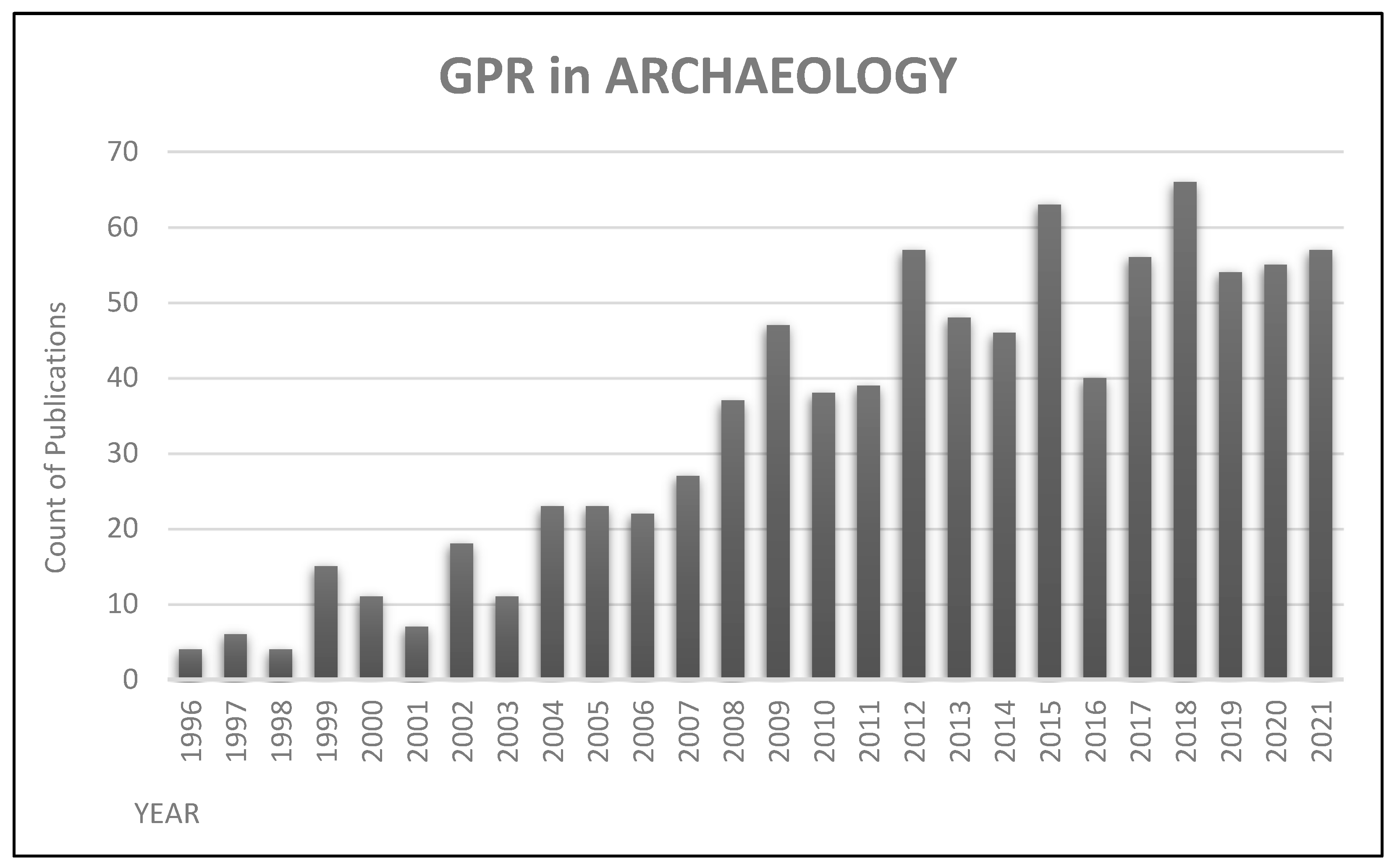
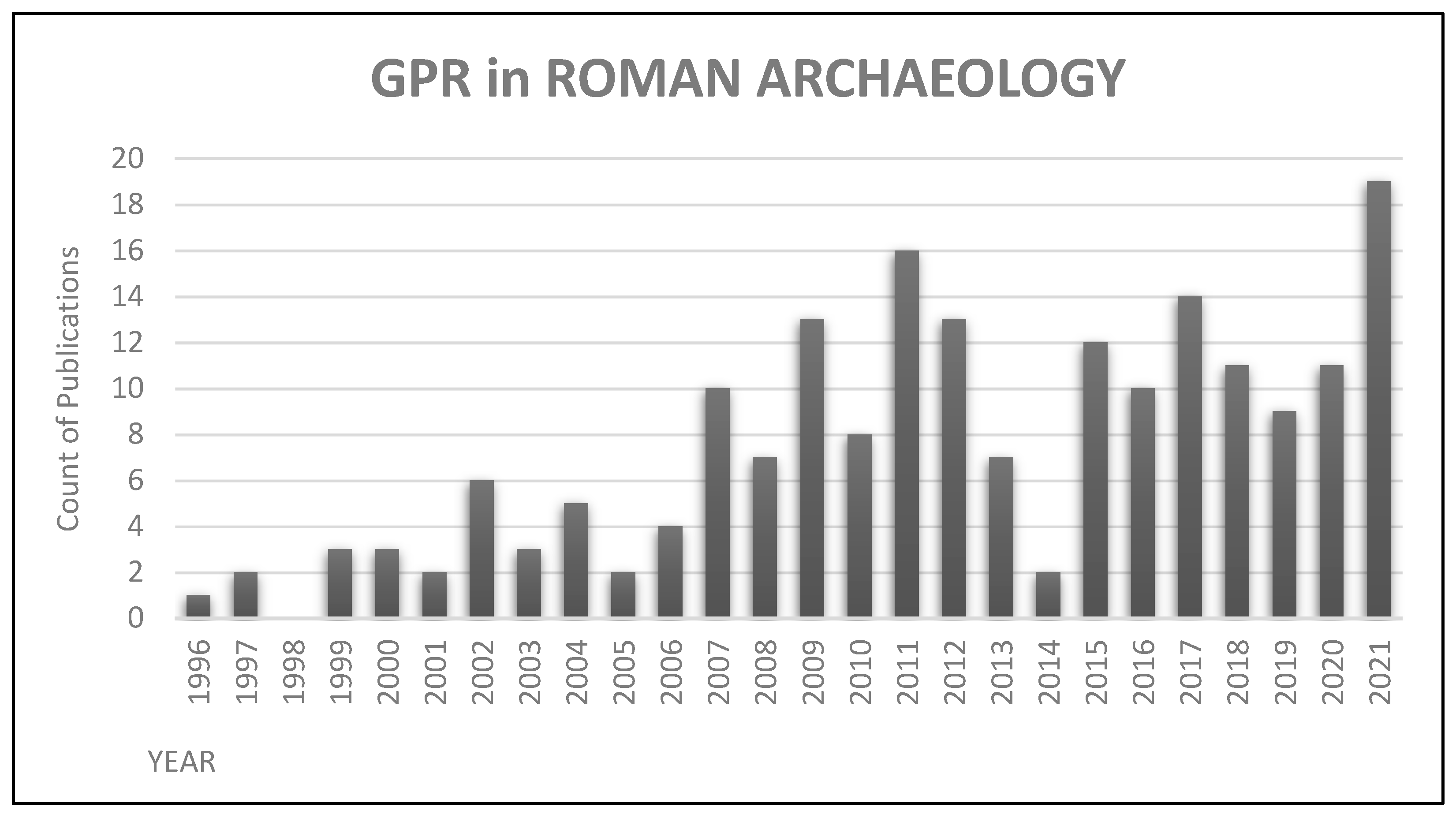
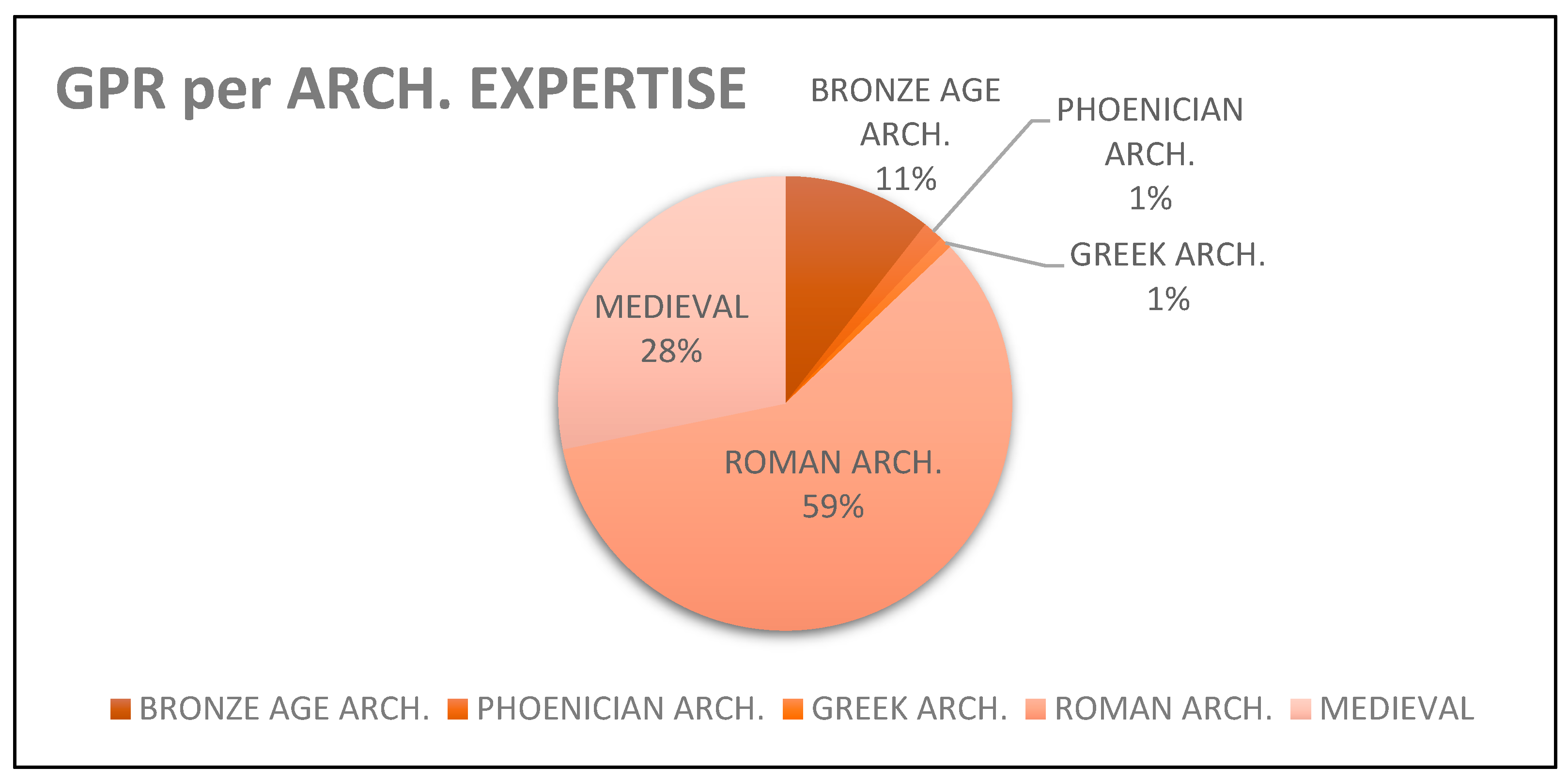
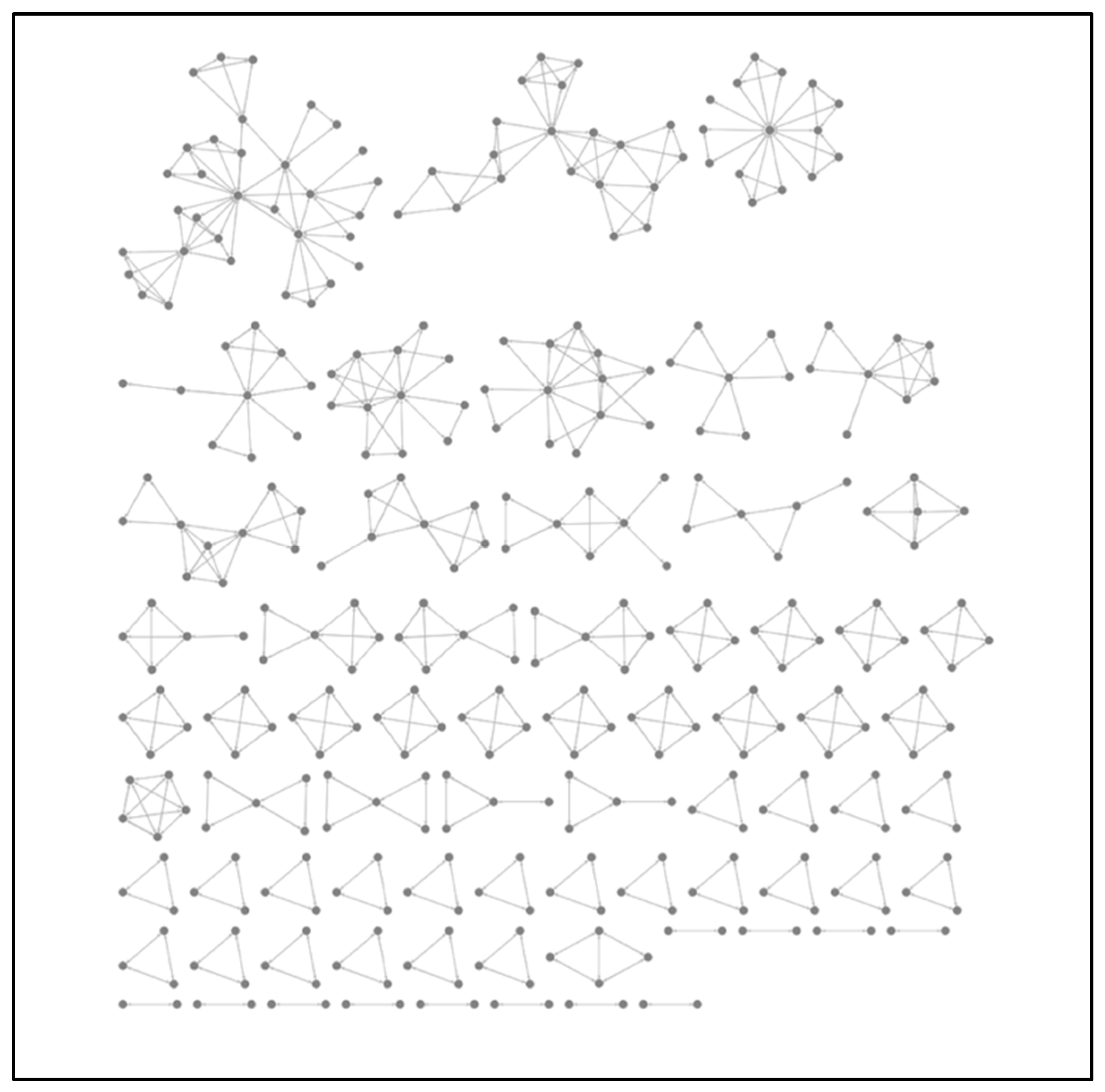
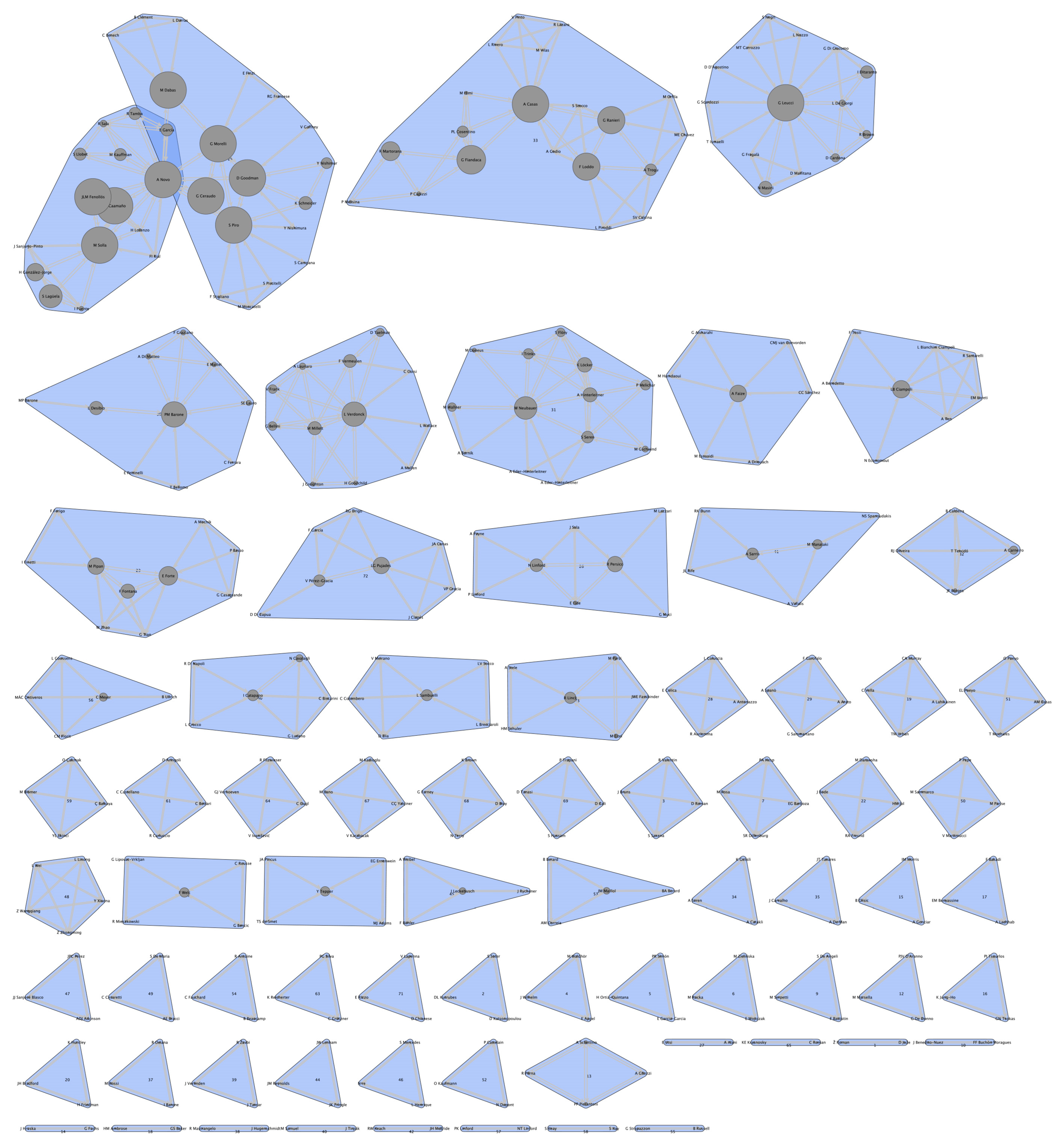

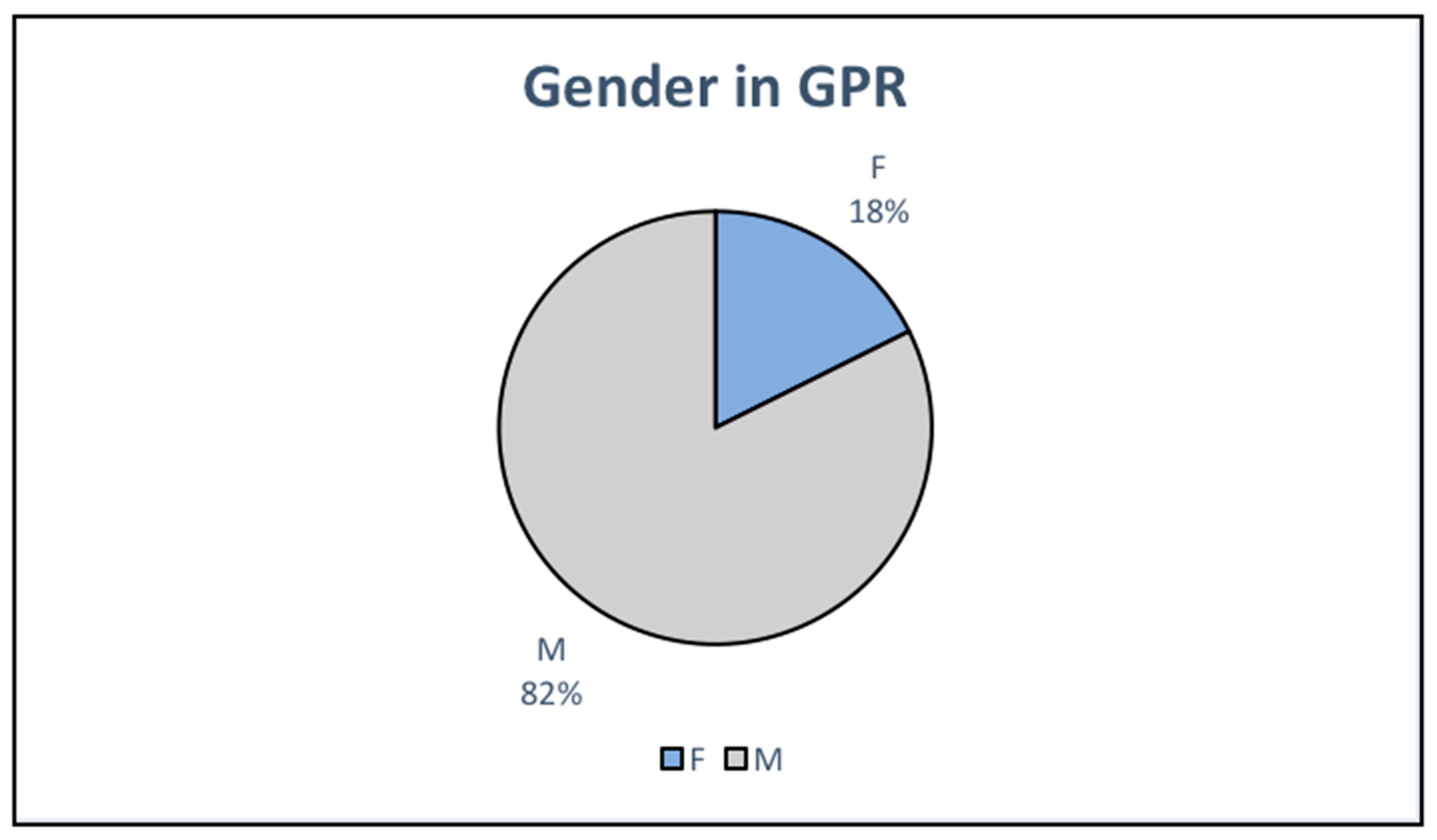



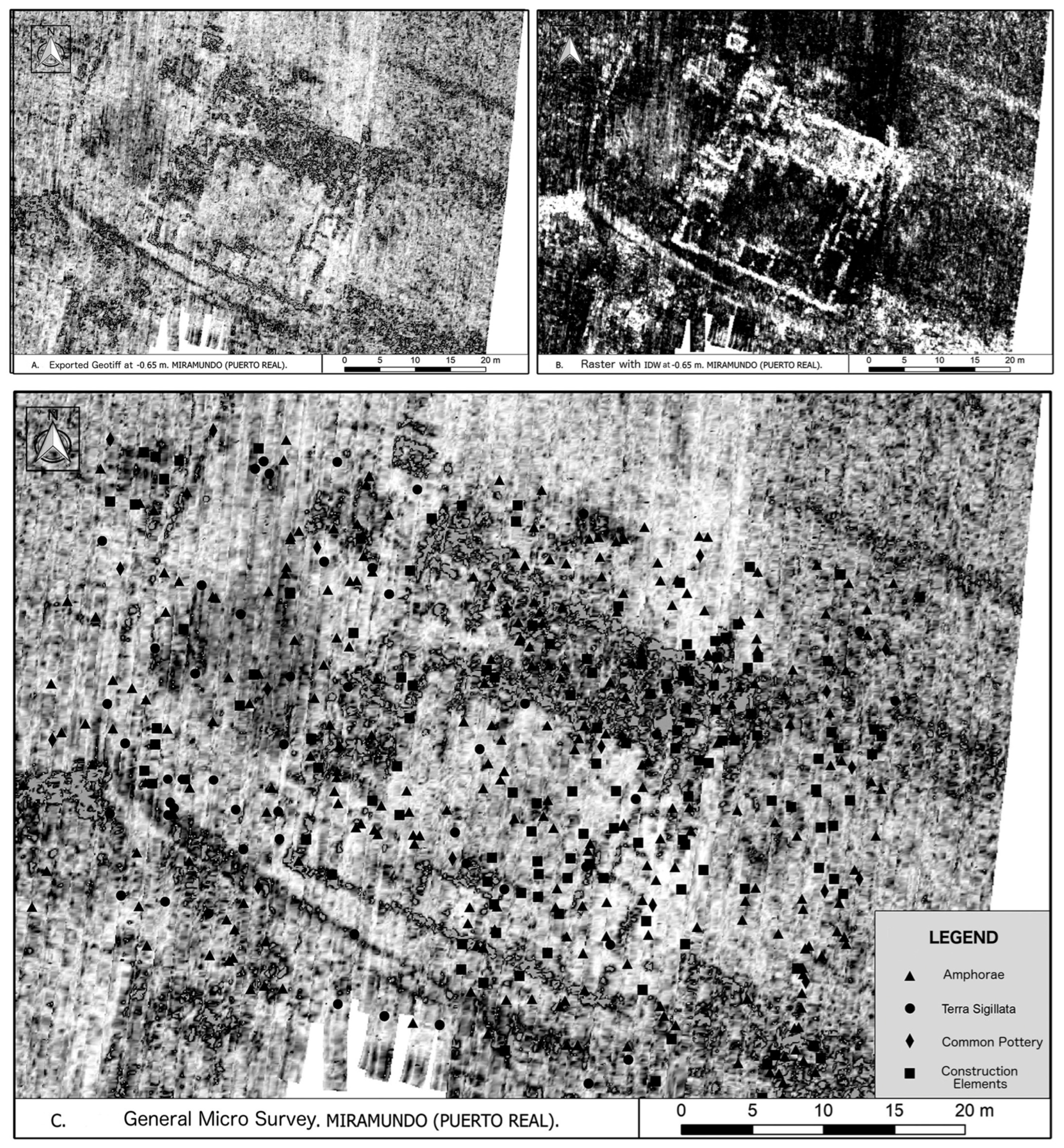
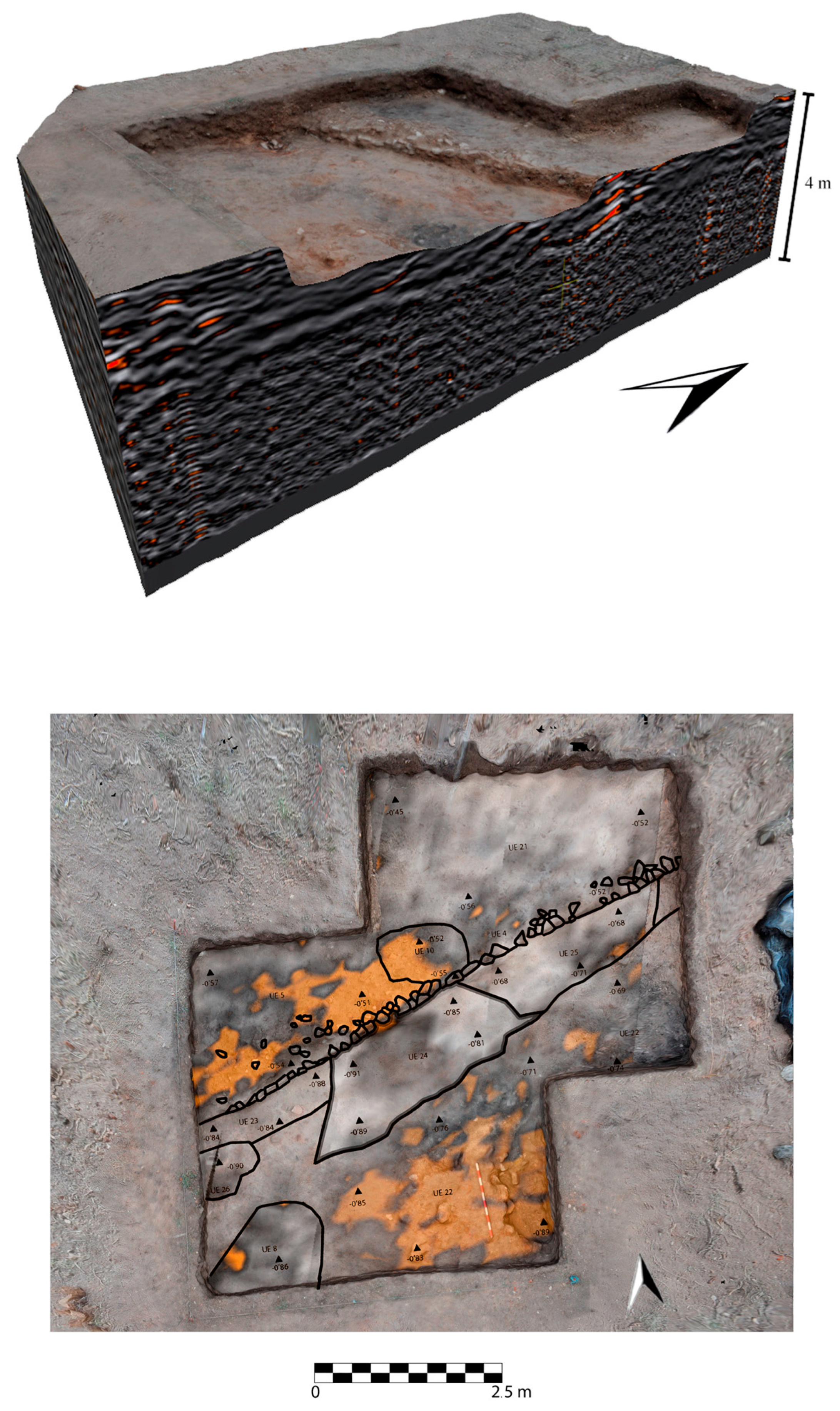
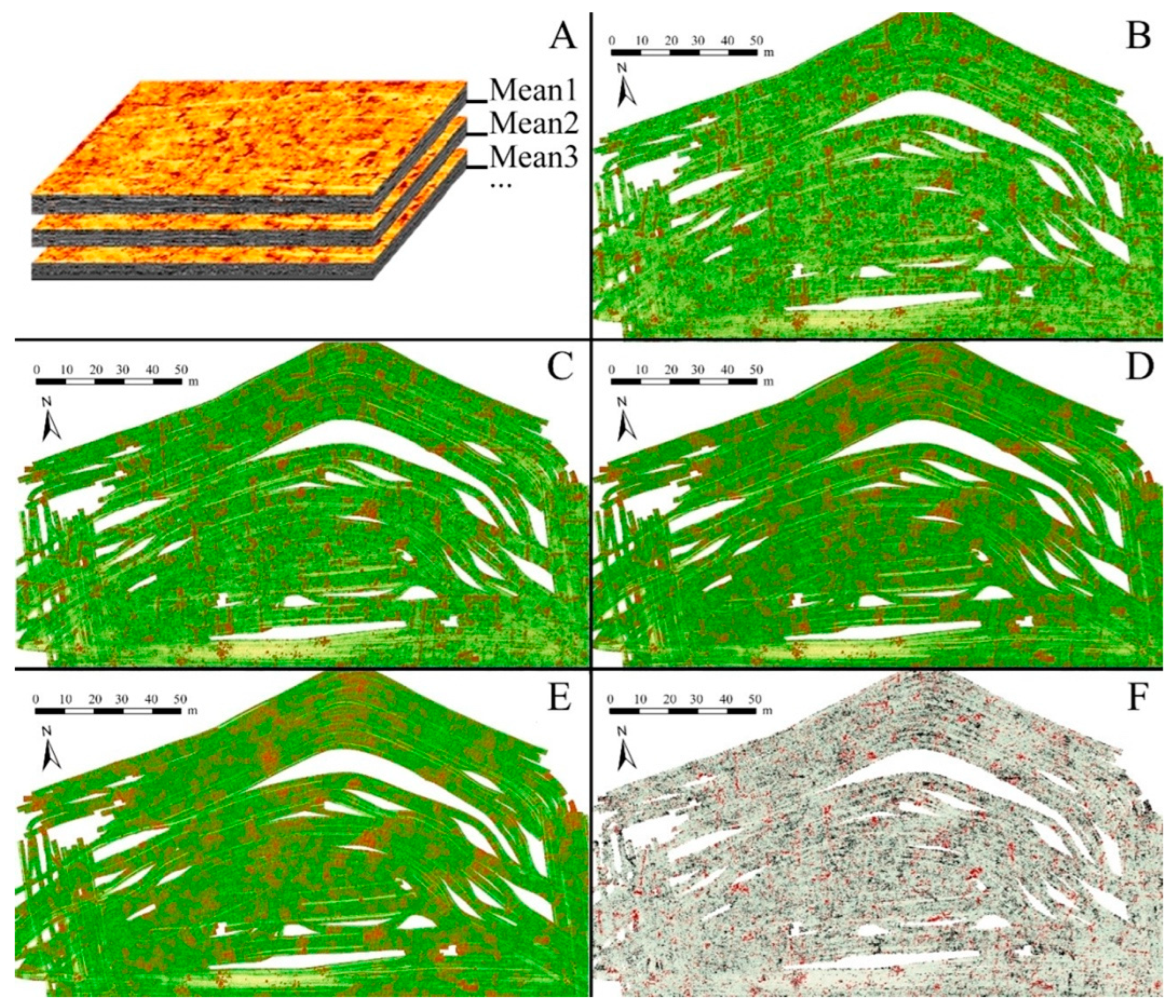
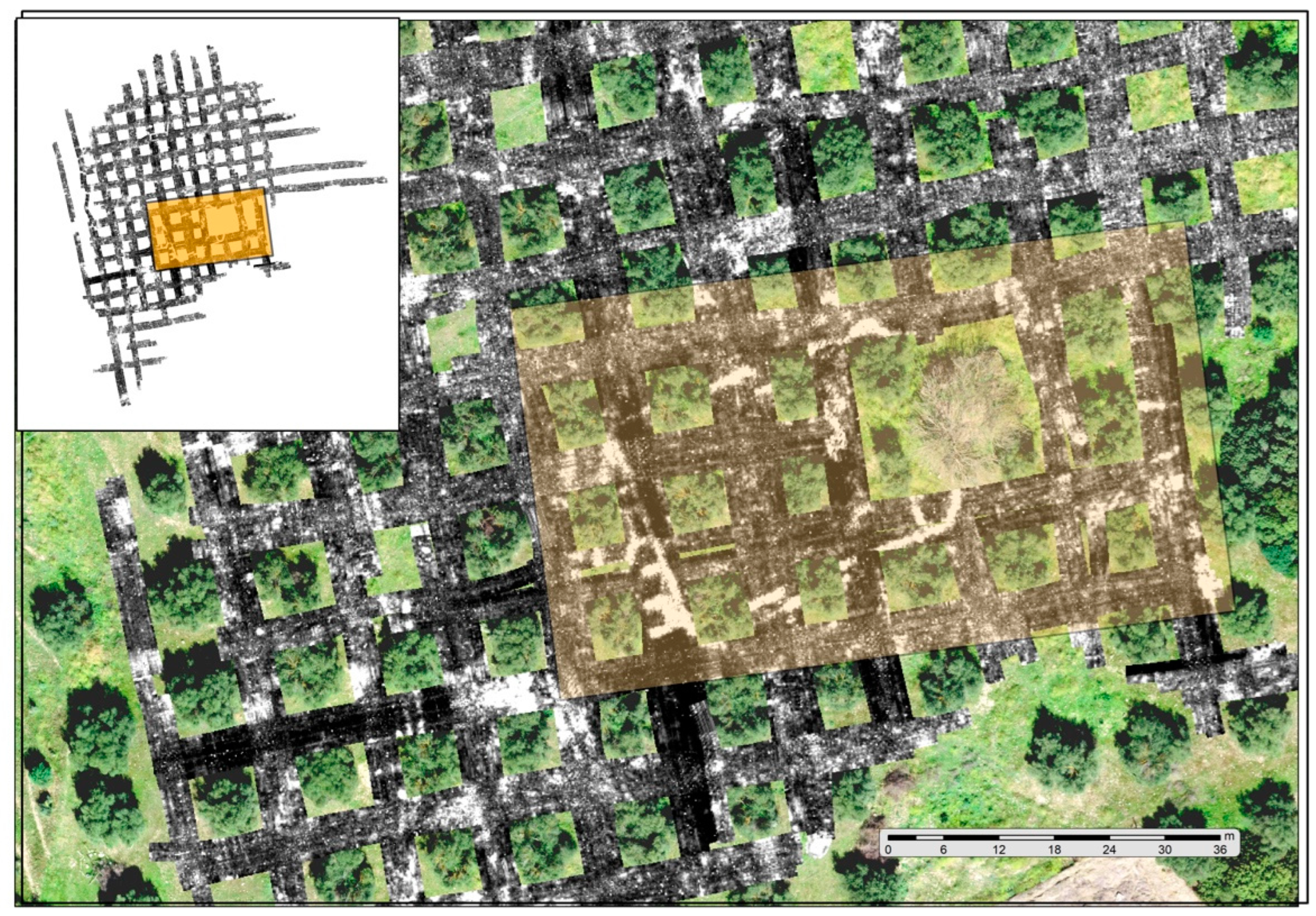
| Type of Publication | Count of Authors |
|---|---|
| Article | 125 |
| Book | 1 |
| Book Chapter | 7 |
| Conference Paper | 60 |
| Conference Review | 0 |
| Review | 6 |
| Grand Total | 199 |
Disclaimer/Publisher’s Note: The statements, opinions and data contained in all publications are solely those of the individual author(s) and contributor(s) and not of MDPI and/or the editor(s). MDPI and/or the editor(s) disclaim responsibility for any injury to people or property resulting from any ideas, methods, instructions or products referred to in the content. |
© 2023 by the authors. Licensee MDPI, Basel, Switzerland. This article is an open access article distributed under the terms and conditions of the Creative Commons Attribution (CC BY) license (https://creativecommons.org/licenses/by/4.0/).
Share and Cite
Lagóstena-Barrios, L.G.; Aragón-Núñez, E. The Contribution of GPR to the Historical Research of Urban and Rural Landscapes of Antiquity. Land 2023, 12, 1165. https://doi.org/10.3390/land12061165
Lagóstena-Barrios LG, Aragón-Núñez E. The Contribution of GPR to the Historical Research of Urban and Rural Landscapes of Antiquity. Land. 2023; 12(6):1165. https://doi.org/10.3390/land12061165
Chicago/Turabian StyleLagóstena-Barrios, Lázaro G., and Enrique Aragón-Núñez. 2023. "The Contribution of GPR to the Historical Research of Urban and Rural Landscapes of Antiquity" Land 12, no. 6: 1165. https://doi.org/10.3390/land12061165
APA StyleLagóstena-Barrios, L. G., & Aragón-Núñez, E. (2023). The Contribution of GPR to the Historical Research of Urban and Rural Landscapes of Antiquity. Land, 12(6), 1165. https://doi.org/10.3390/land12061165







